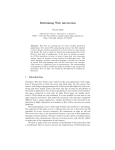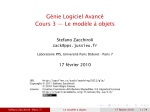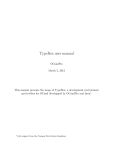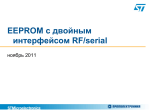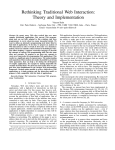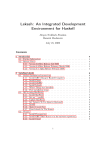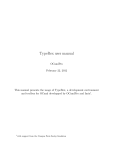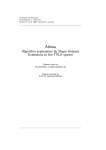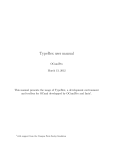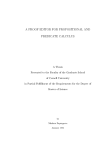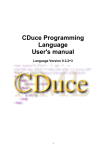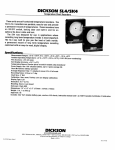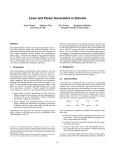Download Menhir Reference Manual - GODI Package Documentation
Transcript
Menhir Reference Manual
(version 20130116)
François Pottier
Yann Régis-Gianas
INRIA
{Francois.Pottier, Yann.Regis-Gianas}@inria.fr
Contents
1
Foreword
3
2
Usage
3
3
Lexical conventions
5
4
Syntax of grammar specifications
4.1 Declarations . . . . . . . . . . .
4.1.1 Headers . . . . . . . . .
4.1.2 Parameters . . . . . . .
4.1.3 Tokens . . . . . . . . .
4.1.4 Priority and associativity
4.1.5 Types . . . . . . . . . .
4.1.6 Start symbols . . . . . .
4.2 Rules . . . . . . . . . . . . . .
4.2.1 Production groups . . .
4.2.2 Productions . . . . . . .
4.2.3 Producers . . . . . . . .
4.2.4 Actuals . . . . . . . . .
5
6
.
.
.
.
.
.
.
.
.
.
.
.
.
.
.
.
.
.
.
.
.
.
.
.
.
.
.
.
.
.
.
.
.
.
.
.
.
.
.
.
.
.
.
.
.
.
.
.
6
6
6
6
7
7
7
7
7
8
8
8
8
.
.
.
.
.
.
.
.
.
.
.
.
.
.
.
.
.
.
.
.
.
.
.
.
.
.
.
.
.
.
.
.
.
.
.
.
.
.
.
.
.
.
.
.
.
.
.
.
.
.
.
.
.
.
.
.
.
.
.
.
.
.
.
.
.
.
.
.
.
.
.
.
.
.
.
.
.
.
.
.
.
.
.
.
.
.
.
.
.
.
.
.
.
.
.
.
.
.
.
.
.
.
.
.
.
.
.
.
.
.
.
.
.
.
.
.
.
.
.
.
.
.
.
.
.
.
.
.
.
.
.
.
.
.
.
.
.
.
.
.
.
.
.
.
.
.
.
.
.
.
.
.
.
.
.
.
.
.
.
.
.
.
.
.
.
.
.
.
.
.
.
.
.
.
.
.
.
.
.
.
.
.
.
.
.
.
.
.
.
.
.
.
.
.
.
.
.
.
.
.
.
.
.
.
.
.
.
.
.
.
.
.
.
.
.
.
.
.
.
.
.
.
.
.
.
.
.
.
.
.
.
.
.
.
.
.
.
.
.
.
.
.
.
.
.
.
.
.
.
.
.
.
.
.
.
.
.
.
.
.
.
.
.
.
.
.
.
.
.
.
.
.
.
.
.
.
.
.
.
.
.
.
.
.
.
.
.
.
.
.
.
.
.
.
.
.
.
.
.
.
.
.
.
.
.
.
.
.
.
.
.
.
.
.
.
.
.
.
.
.
.
.
.
.
.
.
.
.
.
.
.
.
.
.
.
.
.
.
.
.
.
.
.
.
.
.
.
.
.
.
.
.
.
.
.
.
.
.
.
.
Advanced features
5.1 Splitting specifications over multiple files
5.2 Parameterizing rules . . . . . . . . . . .
5.3 Inlining . . . . . . . . . . . . . . . . . .
5.4 The standard library . . . . . . . . . . . .
.
.
.
.
.
.
.
.
.
.
.
.
.
.
.
.
.
.
.
.
.
.
.
.
.
.
.
.
.
.
.
.
.
.
.
.
.
.
.
.
.
.
.
.
.
.
.
.
.
.
.
.
.
.
.
.
.
.
.
.
.
.
.
.
.
.
.
.
.
.
.
.
.
.
.
.
.
.
.
.
.
.
.
.
.
.
.
.
.
.
.
.
.
.
.
.
.
.
.
.
.
.
.
.
.
.
.
.
.
.
.
.
8
. 8
. 9
. 11
. 12
.
.
.
.
12
13
13
17
17
Conflicts
6.1 When is a conflict benign? . . . . . . . . . .
6.2 How are severe conflicts explained? . . . . .
6.3 How are severe conflicts resolved in the end?
6.4 End-of-stream conflicts . . . . . . . . . . . .
.
.
.
.
.
.
.
.
.
.
.
.
.
.
.
.
.
.
.
.
.
.
.
.
.
.
.
.
.
.
.
.
.
.
.
.
.
.
.
.
.
.
.
.
.
.
.
.
.
.
.
.
.
.
.
.
.
.
.
.
.
.
.
.
.
.
.
.
.
.
.
.
.
.
.
.
.
.
.
.
.
.
.
.
.
.
.
.
.
.
.
.
.
.
.
.
.
.
.
.
.
.
.
.
7
Positions
18
8
Error handling and recovery
18
9
Using Menhir as an interpreter
21
9.1 Sentences . . . . . . . . . . . . . . . . . . . . . . . . . . . . . . . . . . . . . . . . . . . . . . 21
9.2 Outcomes . . . . . . . . . . . . . . . . . . . . . . . . . . . . . . . . . . . . . . . . . . . . . . 21
9.3 Remarks . . . . . . . . . . . . . . . . . . . . . . . . . . . . . . . . . . . . . . . . . . . . . . . 22
10 A comparison with ocamlyacc
23
11 Questions and Answers
24
12 Technical background
24
13 Acknowledgements
24
1.
Foreword
Menhir is a parser generator. It turns high-level grammar specifications, decorated with semantic actions
expressed in the Objective Caml programming language [11], into parsers, again expressed in Objective Caml. It
is based on Knuth’s LR(1) parser construction technique [10]. It is strongly inspired by its precursors: yacc [9],
ML-Yacc [14], and ocamlyacc [11], but offers a large number of minor and major improvements that make it a
more modern tool.
This brief reference manual explains how to use Menhir. It does not attempt to explain context-free grammars,
parsing, or the LR technique. Readers who have never used a parser generator are encouraged to read about these
ideas first [1, 2, 7]. They are also invited to have a look at the demos directory in Menhir’s distribution.
At this stage, potential users should be warned about two facts. First, Menhir’s feature set is not stable. There
is a tension between preserving a measure of compatibility with ocamlyacc, on the one hand, and introducing
new ideas, on the other hand. Some aspects of the tool, such as the error handling and recovery mechanism,
are still potentially subject to incompatible changes. Second, the present release is beta-quality. There is much
room for improvement in the tool and in this reference manual. Bug reports and suggestions are welcome!
2.
Usage
Menhir is invoked as follows:
menhir option . . . option filename . . . filename
Each of the file names must end with .mly and denotes a partial grammar specification. These partial grammar
specifications are joined (§5.1) to form a single, self-contained grammar specification, which is then processed.
A number of optional command line switches allow controlling many aspects of the process.
--base basename. This switch controls the base name of the .ml and .mli files that are produced.
That is, the tool will produce files named basename.ml and basename.mli. Note that basename can contain
occurrences of the / character, so it really specifies a path and a base name. When only one filename is provided
on the command line, the default basename is obtained by depriving filename of its final .mly suffix. When
multiple file names are provided on the command line, no default base name exists, so that the --base switch
must be used.
--comment. This switch causes a few comments to be inserted into the Objective Caml code that is written
to the .ml file.
--depend. This switch causes Menhir to generate dependency information for use in conjunction with
make. When invoked in this mode, Menhir does not generate a parser. Instead, it examines the grammar specification and prints a list of prerequisites for the targets basename.cm[oix], basename.ml, and basename.mli.
This list is intended to be textually included within a Makefile. It is important to note that basename.ml and
basename.mli can have .cm[iox] prerequisites. This is because, when the --infer switch is used, Menhir
infers types by invoking ocamlc, and ocamlc itself requires the Objective Caml modules that the grammar
specification depends upon to have been compiled first. The file demos/Makefile.shared helps exploit the
--depend switch.
When in --depend mode, Menhir computes dependencies by invoking ocamldep. The command that is
used to run ocamldep is controlled by the --ocamldep switch.
--dump. This switch causes a description of the automaton to be written to the file basename.automaton.
--error-recovery. This switch causes error recovery code to be generated. Error recovery, also known
as re-synchronization, consists in dropping tokens off the input stream, after an error has been detected, until
a token that can be shifted in the current state is found. This behavior is made optional because it is seldom
exploited and requires extra code in the parser. See also §8.
--explain. This switch causes conflict explanations to be written to the file basename.conflicts. See
also §6.
--external-tokens T. This switch causes the definition of the token type to be omitted in basename.ml
and basename.mli. Instead, the generated parser relies on the type T .token, where T is an Objective Caml
module name. It is up to the user to define module T and to make sure that it exports a suitable token type.
Module T can be hand-written. It can also be automatically generated out of a grammar specification using the
--only-tokens switch.
--graph. This switch causes a description of the grammar’s dependency graph to be written to the file
basename.dot. The graph’s vertices are the grammar’s nonterminal symbols. There is a directed edge from
vertex A to vertex B if the definition of A refers to B. The file is in a format that is suitable for processing by
the graphviz toolkit.
--infer. This switch causes the semantic actions to be checked for type consistency before the parser is
generated. This is done by invoking the Objective Caml compiler. Use of --infer is strongly recommended,
because it helps obtain consistent, well-located type error messages, especially when advanced features such as
Menhir’s standard library or %inline keyword are exploited. One downside of --infer is that the Objective
Caml compiler usually needs to consult a few .cm[iox] files. This means that these files must have been
created first, requiring Makefile changes and use of the --depend switch. The file demos/Makefile.shared
suggests how to deal with this difficulty. Another option is to avoid make altogether and use ocamlbuild, which
has built-in knowledge of Menhir.
--interpret. This switch causes Menhir to act as an interpreter, rather than as a compiler. No Objective
Caml code is generated. Instead, Menhir reads sentences off the standard input channel, parses them, and
displays outcomes. For more information, see §9.
--interpret-show-cst. This switch, used in conjunction with --interpret, causes Menhir to display
a concrete syntax tree when a sentence is successfully parsed. For more information, see §9.
--log-automaton level. When level is nonzero, this switch causes some information about the automaton
to be logged to the standard error channel.
--log-code level. When level is nonzero, this switch causes some information about the generated Objective Caml code to be logged to the standard error channel.
--log-grammar level. When level is nonzero, this switch causes some information about the grammar to be
logged to the standard error channel. When level is 2, the nullable, FIRST, and FOLLOW tables are displayed.
--no-inline. This switch causes all %inline keywords in the grammar specification to be ignored. This
is especially useful in order to understand whether these keywords help solve any conflicts.
--no-stdlib. This switch causes the standard library not to be implicitly joined with the grammar
specifications whose names are explicitly provided on the command line.
--ocamlc command. This switch controls how ocamlc is invoked (when --infer is used). It allows setting
both the name of the executable and the command line options that are passed to it.
--ocamldep command. This switch controls how ocamldep is invoked (when --depend is used). It allows
setting both the name of the executable and the command line options that are passed to it.
--only-preprocess. This switch causes the grammar specifications to be transformed up to the point
where the automaton’s construction can begin. The grammar specifications whose names are provided on
the command line are joined (§5.1); all parameterized nonterminal symbols are expanded away (§5.2); type
inference is performed, if --infer is enabled; all nonterminal symbols marked %inline are expanded away
(§5.3). This yields a single, monolithic grammar specification, which is printed on the standard output channel.
--only-tokens. This switch causes the %token declarations in the grammar specification to be translated
into a definition of the token type, which is written to the files basename.ml and basename.mli. No code is
generated. This is useful when a single set of tokens is to be shared between several parsers. The directory
demos/calc-two contains a demo that illustrates the use of this switch.
--raw-depend. This switch is analogous to --depend, except that ocamldep’s output is not postprocessed
by Menhir; it is echoed without change. This switch is not suitable for direct use with make; it is intended for
use with omake, which performs its own postprocessing.
--strict. This switch causes several warnings about the grammar and about the automaton to be considered errors. This includes warnings about useless precedence declarations, non-terminal symbols that produce
the empty language, unreachable non-terminal symbols, productions that are never reduced, conflicts that are
not resolved by precedence declarations, and end-of-stream conflicts.
--suggest-comp-flags. This switch causes Menhir to print a set of suggested compilation flags, and exit.
These flags are intended to be passed to the Objective Caml compilers (ocamlc or ocamlopt) when compiling
and linking the parser generated by Menhir. What are these flags? In the absence of the --table switch, they
are empty. When --table is set, these flags ensure that MenhirLib is visible to the Objective Caml compiler.
If the support library MenhirLib was installed via ocamlfind, a -package directive is issued; otherwise, a -I
directive is used. The file demos/Makefile.shared shows how to exploit the --suggest-* switches.
--suggest-link-flags-byte. This switch causes Menhir to print a set of suggested link flags, and exit.
These flags are intended to be passed to ocamlc when producing a bytecode executable. What are these flags?
In the absence of the --table switch, they are empty. When --table is set, these flags ensure that MenhirLib
is linked in. If the support library MenhirLib was installed via ocamlfind, a -linkpkg directive is issued;
otherwise, the object file menhirLib.cmo is named. The file demos/Makefile.shared shows how to exploit
the --suggest-* switches.
--suggest-link-flags-opt. This switch causes Menhir to print a set of suggested link flags, and exit.
These flags are intended to be passed to ocamlopt when producing a native code executable. What are these
flags? In the absence of the --table switch, they are empty. When --table is set, these flags ensure that
MenhirLib is linked in. If the support library MenhirLib was installed via ocamlfind, a -linkpkg directive
is issued; otherwise, the object file menhirLib.cmx is named. The file demos/Makefile.shared shows how
to exploit the --suggest-* switches.
--stdlib directory. This switch controls the directory where the standard library is found. It allows
overriding the default directory that is set at installation time. The trailing / character is optional.
--table. This switch causes Menhir to use its table-based back-end, as opposed to its (default) code-based
back-end. When --table is used, Menhir produces significantly more compact, slightly slower parsers.
The table-based back-end produces rather compact tables, which are analogous to those produced by yacc,
bison, or ocamlyacc. These tables are not quite stand-alone: they are exploited by an interpreter, which is
shipped as part of the support library MenhirLib. For this reason, when --table is used, MenhirLib must
be made visible to the Objective Caml compilers, and must be linked into your executable program. The
--suggest-* switches, described above, help do this.
The code-based back-end compiles the LR automaton directly into a nest of mutually recursive Objective
Caml functions. In that case, MenhirLib is not required.
--timings. This switch causes internal timing information to be sent to the standard error channel.
--trace. This switch causes tracing code to be inserted into the generated parser, so that, when the parser
is run, its actions are logged to the standard error channel. This is analogous to ocamlrun’s p=1 parameter,
except this switch must be enabled at compile time: one cannot selectively enable or disable tracing at runtime.
--version. This switch causes Menhir to print its own version number and exit.
3.
Lexical conventions
The semicolon character (;) is treated as insignificant, just like white space. Thus, rules and producers (for
instance) can be separated with semicolons if it is thought that this improves readability. They can be omitted
otherwise.
specification ::= declaration . . . declaration %% rule . . . rule [ %% Objective Caml code ]
declaration ::= %{ Objective Caml code %}
%parameter < uid : Objective Caml module type >
%token [ < Objective Caml type > ] uid . . . uid
%nonassoc uid . . . uid
%left uid . . . uid
%right uid . . . uid
%type < Objective Caml type > lid . . . lid
%start [ < Objective Caml type > ] lid . . . lid
rule ::= [ %public ] [ %inline ] lid [ ( id, . . . , id ) ] : [ | ] group | . . . | group
group ::= production | . . . | production { Objective Caml code } [ %prec id ]
production ::= producer . . . producer [ %prec id ]
producer ::= [ lid = ] actual
actual ::= id [ ( actual, . . . , actual ) ] [ ? | + | * ]
Figure 1. Syntax of grammar specifications
Identifiers (id) coincide with Objective Caml identifiers, except they are not allowed to contain the quote (’)
character. Following Objective Caml, identifiers that begin with a lowercase letter (lid) or with an uppercase
letter (uid) are distinguished.
Comments are C-style (surrounded with /* and */, cannot be nested), C++-style (announced by // and
extending until the end of the line), or Objective Caml-style (surrounded with (* and *), can be nested). Of
course, inside Objective Caml code, only Objective Caml-style comments are allowed.
Objective Caml type expressions are surrounded with < and >. Within such expressions, all references to
type constructors (other than the built-in list, option, etc.) must be fully qualified.
4.
Syntax of grammar specifications
The syntax of grammar specifications appears in Figure 1. (For compatibility with ocamlyacc, some specifications that do not fully adhere to this syntax are also accepted.)
4.1 Declarations
A specification file begins with a sequence of declarations, ended by a mandatory %% keyword.
4.1.1 Headers
A header is a piece of Objective Caml code, surrounded with %{ and %}. It is copied verbatim at the beginning
of the .ml file. It typically contains Objective Caml open directives and function definitions for use by the
semantic actions. If a single grammar specification file contains multiple headers, their order is preserved.
However, when two headers originate in distinct grammar specification files, the order in which they are copied
to the .ml file is unspecified.
4.1.2 Parameters
A declaration of the form:
%parameter < uid : Objective Caml module type >
causes the entire parser to become parameterized over the Objective Caml module uid, that is, to become
an Objective Caml functor. If a single specification file contains multiple %parameter declarations, their
order is preserved, so that the module name uid introduced by one declaration is effectively in scope in the
declarations that follow. When two %parameter declarations originate in distinct grammar specification files,
the order in which they are processed is unspecified. Last, %parameter declarations take effect before %{ . . .
%}, %token, %type, or %start declarations are considered, so that the module name uid introduced by a
%parameter declaration is effectively in scope in all %{ . . . %}, %token, %type, or %start declarations,
regardless of whether they precede or follow the %parameter declaration. This means, in particular, that the
side effects of an Objective Caml header are observed only when the functor is applied, not when it is defined.
4.1.3 Tokens
A declaration of the form:
%token [ < Objective Caml type > ] uid1 , . . . , uidn
defines the identifiers uid1 , . . . , uidn as tokens, that is, as terminal symbols in the grammar specification and as
data constructors in the token type. If an Objective Caml type t is present, then these tokens are considered to
carry a semantic value of type t, otherwise they are considered to carry no semantic value.
4.1.4 Priority and associativity
A declaration of one of the following forms:
%nonassoc uid1 . . . uidn
%left uid1 . . . uidn
%right uid1 . . . uidn
attributes both a priority level and an associativity status to the symbols uid1 , . . . , uidn . The priority level
assigned to uid1 , . . . , uidn is not defined explicitly: instead, it is defined to be higher than the priority level
assigned by the previous %nonassoc, %left, or %right declaration, and lower than that assigned by the next
%nonassoc, %left, or %right declaration. The symbols uid1 , . . . , uidn can be tokens (defined elsewhere by a
%token declaration) or dummies (not defined anywhere). Both can be referred to as part of %prec annotations.
Associativity status and priority levels allow shift/reduce conflicts to be silently resolved (§6).
4.1.5 Types
A declaration of the form:
%type < Objective Caml type > lid1 . . . lidn
assigns an Objective Caml type to each of the nonterminal symbols lid1 , . . . , lidn . For start symbols, providing
an Objective Caml type is mandatory, but is usually done as part of the %start declaration. For other symbols,
it is optional. Providing type information can improve the quality of Objective Caml’s type error messages.
4.1.6 Start symbols
A declaration of the form:
%start [ < Objective Caml type > ] lid1 . . . lidn
declares the nonterminal symbols lid1 , . . . , lidn to be start symbols. Each such symbol must be assigned an
Objective Caml type either as part of the %start declaration or via separate %type declarations. Each of
lid1 , . . . , lidn becomes the name of a function whose signature is published in the .mli file and that can be used
to invoke the parser.
4.2 Rules
Following the mandatory %% keyword, a sequence of rules is expected. Each rule defines a nonterminal
symbol id. In its simplest form, a rule begins with id, followed by a colon character (:), and continues with
a sequence of production groups (§4.2.1). Each production group is preceded with a vertical bar character (|);
the very first bar is optional. The meaning of the bar is choice: the nonterminal symbol id develops to either of
the production groups. We defer explanations of the keyword %public (§5.1), of the keyword %inline (§5.3),
and of the optional formal parameters ( id, . . . , id ) (§5.2).
4.2.1 Production groups
In its simplest form, a production group consists of a single production (§4.2.2), followed by an Objective
Caml semantic action (§4.2.1) and an optional %prec annotation (§4.2.1). A production specifies a sequence of
terminal and nonterminal symbols that should be recognized, and optionally binds identifiers to their semantic
values.
Semantic actions A semantic action is a piece of Objective Caml code that is executed in order to assign a
semantic value to the nonterminal symbol with which this production group is associated. A semantic action
can refer to the (already computed) semantic values of the terminal or nonterminal symbols that appear in
the production via the semantic value identifiers bound by the production. For compatibility with ocamlyacc,
semantic actions can also refer to these semantic values via positional keywords of the form $1, $2, etc. This
style is discouraged.
%prec annotations An annotation of the form %prec uid indicates that the precedence level of the production group is the level assigned to the symbol uid via a previous %nonassoc, %left, or %right declaration
(§4.1.4). In the absence of a %prec annotation, the precedence level assigned to each production is the level
assigned to the rightmost terminal symbol that appears in it. It is undefined if the rightmost terminal symbol has
an undefined precedence level or if the production mentions no terminal symbols at all. The precedence level
assigned to a production is used when resolving shift/reduce conflicts (§6).
Multiple productions in a group If multiple productions are present in a single group, then the semantic action
and precedence annotation are shared between them. This short-hand effectively allows several productions to
share a semantic action and precedence annotation without requiring textual duplication. It is legal only when
every production binds exactly the same set of semantic value identifiers and when no positional semantic value
keywords ($1, etc.) are used.
4.2.2 Productions
A production is a sequence of producers (§4.2.3), optionally followed by a %prec annotation (§4.2.1). If a
precedence annotation is present, it applies to this production alone, not to other productions in the production
group. It is illegal for a production and its production group to both carry %prec annotations.
4.2.3 Producers
A producer is an actual (§4.2.4), optionally preceded with a binding of a semantic value identifier, of the form lid
=. The actual specifies which construction should be recognized and how a semantic value should be computed
for that construction. The identifier lid, if present, becomes bound to that semantic value in the semantic action
that follows. Otherwise, the semantic value can be referred to via a positional keyword ($1, etc.).
4.2.4 Actuals
In its simplest form, an actual simply consists of a terminal or nonterminal symbol. The optional actual
parameters ( actual, . . . , actual ) and the optional modifier (?, +, or *) are explained further on (see §5.2
and Figure 2).
5.
Advanced features
5.1 Splitting specifications over multiple files
Modules Grammar specifications can be split over multiple files. When Menhir is invoked with multiple
argument file names, it considers each of these files as a partial grammar specification, and joins these partial
specifications in order to obtain a single, complete specification.
This feature is intended to promote a form a modularity. It is hoped that, by splitting large grammar
specifications into several “modules”, they can be made more manageable. It is also hoped that this mechanism,
in conjunction with parameterization (§5.2), will promote sharing and reuse. It should be noted, however, that
this is only a weak form of modularity. Indeed, partial specifications cannot be independently processed (say,
checked for conflicts). It is necessary to first join them, so as to form a complete grammar specification, before
any kind of grammar analysis can be done.
This mechanism is, in fact, how Menhir’s standard library (§5.4) is made available: even though its name
does not appear on the command line, it is automatically joined with the user’s explicitly-provided grammar
specifications, making the standard library’s definitions globally visible.
A partial grammar specification, or module, contains declarations and rules, just like a complete one: there is
no visible difference. Of course, it can consist of only declarations, or only rules, if the user so chooses. (Don’t
forget the mandatory %% keyword that separates declarations and rules. It must be present, even if one of the
two sections is empty.)
Private and public nonterminal symbols It should be noted that joining is not a purely textual process. If
two modules happen to define a nonterminal symbol by the same name, then it is considered, by default, that
this is an accidental name clash. In that case, each of the two nonterminal symbols is silently renamed so as to
avoid the clash. In other words, by default, a nonterminal symbol defined in module A is considered private,
and cannot be defined again, or referred to, in module B.
Naturally, it is sometimes desirable to define a nonterminal symbol N in module A and to refer to it in module
B. This is permitted if N is public, that is, if either its definition carries the keyword %public or N is declared
to be a start symbol. A public nonterminal symbol is never renamed, so it can be referred to by modules other
than its defining module.
In fact, it is even permitted to split the definition of a public nonterminal symbol over multiple modules.
That is, a public nonterminal symbol N can have multiple definitions in distinct modules. When the modules
are joined, the definitions are joined as well, using the choice (|) operator. This feature allows splitting
a grammar specification in a manner that is independent of the grammar’s structure. For instance, in the
grammar of a programming language, the definition of the nonterminal symbol expression could be split into
multiple modules, where one module groups the expression forms that have to do with arithmetic, one module
groups those that concern function definitions and function calls, one module groups those that concern object
definitions and method calls, and so on.
Tokens aside Another use of modularity consists in placing all %token declarations in one module, and
the actual grammar specification in another module. The module that contains the token definitions can then
be shared, making it easier to define multiple parsers that accept the same type of tokens. (On this topic, see
demos/calc-two.)
5.2 Parameterizing rules
A rule (that is, the definition of a nonterminal symbol) can be parameterized over an arbitrary number of
symbols, which are referred to as formal parameters.
Example For instance, here is the definition of the parameterized nonterminal symbol option, taken from the
standard library (§5.4):
%public option(X):
| { None }
| x = X { Some x }
This definition states that option(X) expands to either the empty string, producing the semantic value None, or
to the string X, producing the semantic value Some x, where x is the semantic value of X. In this definition, the
symbol X is abstract: it stands for an arbitrary terminal or nonterminal symbol. The definition is made public,
so option can be referred to within client modules.
A client that wishes to use option simply refers to it, together with an actual parameter – a symbol that is
intended to replace X. For instance, here is how one might define a sequence of declarations, preceded with
optional commas:
actual? is syntactic sugar for option(actual)
actual+ is syntactic sugar for nonempty list(actual)
actual* is syntactic sugar for list(actual)
Figure 2. Syntactic sugar for simulating regular expressions
declarations:
| { [] }
| ds = declarations; option(COMMA); d = declaration { d :: ds }
This definition states that declarations expands either to the empty string or to declarations followed by an
optional comma followed by declaration. (Here, COMMA is presumably a terminal symbol.) When this rule is
encountered, the definition of option is instantiated: that is, a copy of the definition, where COMMA replaces X,
is produced. Things behave exactly as if one had written:
optional comma:
| { None }
| x = COMMA { Some x }
declarations:
| { [] }
| ds = declarations; optional comma; d = declaration { d :: ds }
Note that, even though COMMA presumably has been declared as a token with no semantic value, writing
x = COMMA is legal, and binds x to the unit value. This design choice ensures that the definition of option
makes sense regardless of the nature of X: that is, X can be instantiated with a terminal symbol, with or without
a semantic value, or with a nonterminal symbol.
Parameterization in general In general, the definition of a nonterminal symbol N can be parameterized with
an arbitrary number of formal parameters. When N is referred to within a production, it must be applied to the
same number of actuals. In general, an actual is:
• either a single symbol, which can be a terminal symbol, a nonterminal symbol, or a formal parameter;
• or an application of such a symbol to a number of actuals.
For instance, here is a rule whose single production consists of a single producer, which contains several,
nested actuals. (This example is discussed again in §5.4.)
plist(X):
| xs = loption(delimited(LPAREN, separated nonempty list(COMMA, X), RPAREN)) { xs }
Applications of the parameterized nonterminal symbols option, nonempty list, and list, which are defined in
the standard library (§5.4), can be written using a familiar, regular-expression like syntax (Figure 2).
Higher-order parameters A formal parameter can itself expect parameters. For instance, here is a rule that
defines the syntax of procedures in an imaginary programming language:
procedure(list):
| PROCEDURE ID list(formal) SEMICOLON block SEMICOLON { . . . }
This rule states that the token ID, which represents the name of the procedure, should be followed with
a list of formal parameters. (The definitions of the nonterminal symbols formal and block are not shown.)
However, because list is a formal parameter, as opposed to a concrete nonterminal symbol defined elsewhere,
this definition does not specify how the list is laid out: which token, if any, is used to separate, or terminate,
list elements? is the list allowed to be empty? and so on. A more concrete notion of procedure is obtained
by instantiating the formal parameter list: for instance, procedure(plist), where plist is the parameterized
nonterminal symbol defined earlier, is a valid application.
Consistency Definitions and uses of parameterized nonterminal symbols are checked for consistency before
they are expanded away. In short, it is checked that, wherever a nonterminal symbol is used, it is supplied
with actual arguments in appropriate number and of appropriate nature. This guarantees that expansion of
parameterized definitions terminates and produces a well-formed grammar as its outcome.
5.3 Inlining
It is well-known that the following grammar of arithmetic expressions does not work as expected: that is, in
spite of the priority declarations, it has shift/reduce conflicts.
%token < int > INT
%token PLUS TIMES
%left PLUS
%left TIMES
%%
expression:
| i = INT { i }
| e = expression; o = op; f = expression { o e f }
op:
| PLUS { ( + ) }
| TIMES { ( * ) }
The trouble is, the precedence level of the production expression → expression op expression is undefined, and
there is no sensible way of defining it via a %prec declaration, since the desired level really depends upon the
symbol that was recognized by op: was it PLUS or TIMES?
The standard workaround is to abandon the definition of op as a separate nonterminal symbol, and to inline
its definition into the definition of expression, like this:
expression:
| i = INT { i }
| e = expression; PLUS; f = expression { e + f }
| e = expression; TIMES; f = expression { e * f }
This avoids the shift/reduce conflict, but gives up some of the original specification’s structure, which,
in realistic situations, can be damageable. Fortunately, Menhir offers a way of avoiding the conflict without
manually transforming the grammar, by declaring that the nonterminal symbol op should be inlined:
expression:
| i = INT { i }
| e = expression; o = op; f = expression { o e f }
%inline op:
| PLUS { ( + ) }
| TIMES { ( * ) }
The %inline keyword causes all references to op to be replaced with its definition. In this example, the definition
of op involves two productions, one that develops to PLUS and one that expands to TIMES, so every production
that refers to op is effectively turned into two productions, one that refers to PLUS and one that refers to TIMES.
After inlining, op disappears and expression has three productions: that is, the result of inlining is exactly the
manual workaround shown above.
In some situations, inlining can also help recover a slight efficiency margin. For instance, the definition:
Name
Recognizes
Produces
option(X)
ioption(X)
boption(X)
loption(X)
|X
|X
|X
|X
α option, if X : α
α option, if X : α
bool
α list, if X : α list
pair(X, Y)
separated pair(X, sep, Y)
preceded(opening, X)
terminated(X, closing)
delimited(opening, X, closing)
XY
X sep Y
opening X
X closing
opening X closing
α × β, if X : α and Y : β
α × β, if X : α and Y : β
α, if X : α
α, if X : α
α, if X : α
list(X)
nonempty list(X)
separated list(sep, X)
a possibly empty sequence of X’s
a nonempty sequence of X’s
a possibly empty sequence of X’s
separated with sep’s
a nonempty sequence of X’s separated with sep’s
α list, if X : α
α list, if X : α
α list, if X : α
separated nonempty list(sep, X)
Comment
(inlined)
α list, if X : α
Figure 3. Summary of the standard library
%inline plist(X):
| xs = loption(delimited(LPAREN, separated nonempty list(COMMA, X), RPAREN)) { xs }
effectively makes plist(X) an alias for the right-hand side loption(. . .). Without the %inline keyword, the
language recognized by the grammar would be the same, but the LR automaton would probably have one
more state and would perform one more reduction at run time.
5.4 The standard library
Once equipped with a rudimentary module system (§5.1), parameterization (§5.2), and inlining (§5.3), it is
straightforward to propose a collection of commonly used definitions, such as options, sequences, lists, and so
on. This standard library is joined, by default, with every grammar specification. A summary of the nonterminal
symbols offered by the standard library appears in Figure 3. See also the short-hands documented in Figure 2.
By relying on the standard library, a client module can concisely define more elaborate notions. For instance,
the following rule:
%inline plist(X):
| xs = loption(delimited(LPAREN, separated nonempty list(COMMA, X), RPAREN)) { xs }
causes plist(X) to recognize a list of X’s, where the empty list is represented by the empty string, and a nonempty list is delimited with parentheses and comma-separated.
6.
Conflicts
When a shift/reduce or reduce/reduce conflict is detected, it is classified as either benign, if it can be resolved
by consulting user-supplied precedence declarations, or severe, if it cannot. Benign conflicts are not reported.
Severe conflicts are reported and, if the --explain switch is on, explained.
%token IF THEN ELSE
%start < expression > expression
%%
expression:
| ...
| IF b = expression THEN e = expression { . . . }
| IF b = expression THEN e = expression ELSE f = expression { . . . }
| ...
Figure 4. Basic example of a shift/reduce conflict
6.1 When is a conflict benign?
A shift/reduce conflict involves a single token (the one that one might wish to shift) and one or more productions
(those that one might wish to reduce). When such a conflict is detected, the precedence level (§4.1.4, §4.2.1) of
these entities are looked up and compared as follows:
1. if only one production is involved, and if it has higher priority than the token, then the conflict is resolved in
favor of reduction.
2. if only one production is involved, and if it has the same priority as the token, then the associativity status of
the token is looked up:
(a) if the token was declared nonassociative, then the conflict is resolved in favor of neither action, that is, a
syntax error will be signaled if this token shows up when this production is about to be reduced;
(b) if the token was declared left-associative, then the conflict is resolved in favor of reduction;
(c) if the token was declared right-associative, then the conflict is resolved in favor of shifting.
3. if multiple productions are involved, and if, considered one by one, they all cause the conflict to be resolved
in the same way (that is, either in favor in shifting, or in favor of neither), then the conflict is resolved in that
way.
In either of these cases, the conflict is considered benign. Otherwise, it is considered severe. Note that a
reduce/reduce conflict is always considered severe, unless it happens to be subsumed by a benign multi-way
shift/reduce conflict (item 3 above).
6.2 How are severe conflicts explained?
When the --dump switch is on, a description of the automaton is written to the .automaton file. Severe conflicts
are shown as part of this description. Fortunately, there is also a way of understanding conflicts in terms of the
grammar, rather than in terms of the automaton. When the --explain switch is on, a textual explanation is
written to the .conflicts file.
Not all conflicts are explained in this file: instead, only one conflict per automaton state is explained. This is
done partly in the interest of brevity, but also because Pager’s algorithm can create artificial conflicts in a state
that already contains a true LR(1) conflict; thus, one cannot hope in general to explain all of the conflicts that
appear in the automaton. As a result of this policy, once all conflicts explained in the .conflicts file have
been fixed, one might need to run Menhir again to produce yet more conflict explanations.
How the conflict state is reached Figure 4 shows a grammar specification with a typical shift/reduce conflict.
When this specification is analyzed, the conflict is detected, and an explanation is written to the .conflicts
file. The explanation first indicates in which state the conflict lies by showing how that state is reached. Here, it
is reached after recognizing the following string of terminal and nonterminal symbols—the conflict string:
expression
IF
expression
IF
THEN
expression
expression
THEN
expression
ELSE
expression
Figure 5. A partial derivation tree that justifies shifting
expression
IF expression THEN expression
IF expression THEN expression . ELSE expression
Figure 6. A textual version of the tree in Figure 5
IF expression THEN IF expression THEN expression
Allowing the conflict string to contain both nonterminal and terminal symbols usually makes it shorter and
more readable. If desired, a conflict string composed purely of terminal symbols could be obtained by replacing
each occurrence of a nonterminal symbol N with an arbitrary N -sentence.
The conflict string can be thought of as a path that leads from one of the automaton’s start states to the
conflict state. When multiple such paths exist, the one that is displayed is chosen shortest. Nevertheless, it
may sometimes be quite long. In that case, artificially (and temporarily) declaring some existing nonterminal
symbols to be start symbols has the effect of adding new start states to the automaton and can help produce
shorter conflict strings. Here, expression was declared to be a start symbol, which is why the conflict string is
quite short.
In addition to the conflict string, the .conflicts file also states that the conflict token is ELSE. That is,
when the automaton has recognized the conflict string and when the lookahead token (the next token on the
input stream) is ELSE, a conflict arises. A conflict corresponds to a choice: the automaton is faced with several
possible actions, and does not know which one should be taken. This indicates that the grammar is not LR(1).
The grammar may or may not be inherently ambiguous.
In our example, the conflict string and the conflict token are enough to understand why there is a conflict:
when two IF constructs are nested, it is ambiguous which of the two constructs the ELSE branch should be
associated with. Nevertheless, the .conflicts file provides further information: it explicitly shows that there
exists a conflict, by proving that two distinct actions are possible. Here, one of these actions consists in shifting,
while the other consists in reducing: this is a shift/reduce conflict.
A proof takes the form of a partial derivation tree whose fringe begins with the conflict string, followed
by the conflict token. A derivation tree is a tree whose nodes are labeled with symbols. The root node carries
a start symbol. A node that carries a terminal symbol is considered a leaf, and has no children. A node that
carries a nonterminal symbol N either is considered a leaf, and has no children; or is not considered a leaf, and
has n children, where n ≥ 0, labeled x1 , . . . , xn , where N → x1 , . . . , xn is a production. The fringe of a partial
derivation tree is the string of terminal and nonterminal symbols carried by the tree’s leaves. A string of terminal
and nonterminal symbols that is the fringe of some partial derivation tree is a sentential form.
Why shifting is legal In our example, the proof that shifting is possible is the derivation tree shown in Figures 5
and 6. At the root of the tree is the grammar’s start symbol, expression. This symbol develops into the string
IF expression THEN expression, which forms the tree’s second level. The second occurrence of expression in
that string develops into IF expression THEN expression ELSE expression, which forms the tree’s last level.
The tree’s fringe, a sentential form, is the string IF expression THEN IF expression THEN expression ELSE
expression
IF
expression
THEN
IF
expression
expression
THEN
ELSE
expression
expression
Figure 7. A partial derivation tree that justifies reducing
expression
IF expression THEN expression ELSE expression
IF expression THEN expression .
// lookahead token appears
Figure 8. A textual version of the tree in Figure 7
expression. As announced earlier, it begins with the conflict string IF expression THEN IF expression THEN
expression, followed with the conflict token ELSE.
In Figure 6, the end of the conflict string is materialized with a dot. Note that this dot does not occupy the
rightmost position in the tree’s last level. In other words, the conflict token (ELSE) itself occurs on the tree’s
last level. In practical terms, this means that, after the automaton has recognized the conflict string and peeked
at the conflict token, it makes sense for it to shift that token.
Why reducing is legal In our example, the proof that shifting is possible is the derivation tree shown in
Figures 7 and 8. Again, the sentential form found at the fringe of the tree begins with the conflict string, followed
with the conflict token.
Again, in Figure 8, the end of the conflict string is materialized with a dot. Note that, this time, the dot
occupies the rightmost position in the tree’s last level. In other words, the conflict token (ELSE) appeared on an
earlier level (here, on the second level). This fact is emphasized by the comment // lookahead token appears found
at the second level. In practical terms, this means that, after the automaton has recognized the conflict string
and peeked at the conflict token, it makes sense for it to reduce the production that corresponds to the tree’s last
level—here, the production is expression → IF expression THEN expression.
An example of a more complex derivation tree Figures 9 and 10 show a partial derivation tree that justifies
reduction in a more complex situation. (This derivation tree is relative to a grammar that is not shown.) Here,
the conflict string is DATA UIDENT EQUALS UIDENT; the conflict token is LIDENT. It is quite clear that the
fringe of the tree begins with the conflict string. However, in this case, the fringe does not explicitly exhibit the
conflict token. Let us examine the tree more closely and answer the question: following UIDENT, what’s the
next terminal symbol on the fringe?
First, note that opt type exprs is not a leaf node, even though it has no children. The grammar contains the
production opt type exprs → : the nonterminal symbol opt type exprs develops to the empty string. (This is
made clear in Figure 10, where a single dot appears immediately below opt type exprs.) Thus, opt type exprs is
not part of the fringe.
Next, note that opt type exprs is the rightmost symbol within its level. Thus, in order to find the next symbol
on the fringe, we have to look up one level. This is the meaning of the comment // lookahead token is inherited.
Similarly, tycon item and tycon expr appear rightmost within their level, so we again have to look further up.
This brings us back to the tree’s second level. There, decl is not the rightmost symbol: next to it, we find
opt semi and decls. Does this mean that opt semi is the next symbol on the fringe? Yes and no. opt semi is a
nonterminal symbol, but we are really interested in finding out what the next terminal symbol on the fringe
decls
decl
DATA
UIDENT
opt semi
EQUALS
decls
tycon expr
tycon item
UIDENT
opt type exprs
.
Figure 9. A partial derivation tree that justifies reducing
decls
decl opt semi decls
// lookahead token appears because opt semi can vanish and decls can begin with LIDENT
DATA UIDENT EQUALS tycon expr
// lookahead token is inherited
tycon item
// lookahead token is inherited
UIDENT opt type exprs
// lookahead token is inherited
.
Figure 10. A textual version of the tree in Figure 9
could be. The partial derivation tree shown in Figures 9 and 10 does not explicitly answer this question. In order
to answer it, we need to know more about opt semi and decls.
Here, opt semi stands (as one might have guessed) for an optional semicolon, so the grammar contains a
production opt semi → . This is indicated by the comment // opt semi can vanish. (Nonterminal symbols that
generate are also said to be nullable.) Thus, one could choose to turn this partial derivation tree into a larger
one by developing opt semi into , making it a non-leaf node. That would yield a new partial derivation tree
where the next symbol on the fringe, following UIDENT, is decls.
Now, what about decls? Again, it is a nonterminal symbol, and we are really interested in finding out what the
next terminal symbol on the fringe could be. Again, we need to imagine how this partial derivation tree could
be turned into a larger one by developing decls. Here, the grammar happens to contain a production of the form
decls → LIDENT . . . This is indicated by the comment // decls can begin with LIDENT. Thus, by developing decls,
it is possible to construct a partial derivation tree where the next symbol on the fringe, following UIDENT, is
LIDENT. This is precisely the conflict token.
To sum up, there exists a partial derivation tree whose fringe begins the conflict string, followed with the
conflict token. Furthermore, in that derivation tree, the dot occupies the rightmost position in the last level. As
in our previous example, this means that, after the automaton has recognized the conflict string and peeked at
the conflict token, it makes sense for it to reduce the production that corresponds to the tree’s last level—here,
the production is opt type exprs → .
Greatest common factor among derivation trees Understanding conflicts requires comparing two (or more)
derivation trees. It is frequent for these trees to exhibit a common factor, that is, to exhibit identical structure
near the top of the tree, and to differ only below a specific node. Manual identification of that node can be
tedious, so Menhir performs this work automatically. When explaining a n-way conflict, it first displays the
greatest common factor of the n derivation trees. A question mark symbol (?) is used to identify the node where
the trees begin to differ. Then, Menhir displays each of the n derivation trees, without their common factor –
that is, it displays n sub-trees that actually begin to differ at the root. This should make visual comparisons
significantly easier.
6.3 How are severe conflicts resolved in the end?
It is unspecified how severe conflicts are resolved. Menhir attempts to mimic ocamlyacc’s specification,
that is, to resolve shift/reduce conflicts in favor of shifting, and to resolve reduce/reduce conflicts in favor
of the production that textually appears earliest in the grammar specification. However, this specification is
inconsistent in case of three-way conflicts, that is, conflicts that simultaneously involve a shift action and several
reduction actions. Furthermore, textual precedence can be undefined when the grammar specification is split
over multiple modules. In short, Menhir’s philosophy is that
severe conflicts should not be tolerated,
so you should not care how they are resolved.
6.4 End-of-stream conflicts
Menhir’s treatment of the end of the token stream is (believed to be) fully compatible with ocamlyacc’s. Yet,
Menhir attempts to be more user-friendly by warning about a class of so-called “end-of-stream conflicts”.
How the end of stream is handled In many textbooks on parsing, it is assumed that the lexical analyzer, which
produces the token stream, produces a special token, written #, to signal that the end of the token stream has
been reached. A parser generator can take advantage of this by transforming the grammar: for each start symbol
S in the original grammar, a new start symbol S’ is defined, together with the production S 0 → S#. The symbol
S is no longer a start symbol in the new grammar. This means that the parser will accept a sentence derived
from S only if it is immediately followed by the end of the token stream.
This approach has the advantage of simplicity. However, ocamlyacc and Menhir do not follow it, for several
reasons. Perhaps the most convincing one is that it is not flexible enough: sometimes, it is desirable to recognize
a sentence derived from S, without requiring that it be followed by the end of the token stream: this is the case,
for instance, when reading commands, one by one, on the standard input channel. In that case, there is no end
of stream: the token stream is conceptually infinite. Furthermore, after a command has been recognized, we do
not wish to examine the next token, because doing so might cause the program to block, waiting for more input.
In short, ocamlyacc and Menhir’s approach is to recognize a sentence derived from S and to not look, if
possible, at what follows. However, this is possible only if the definition of S is such that the end of an Ssentence is identifiable without knowledge of the lookahead token. When the definition of S does not satisfy
this criterion, and end-of-stream conflict arises: after a potential S-sentence has been read, there can be a tension
between consulting the next token, in order to determine whether the sentence is continued, and not consulting
the next token, because the sentence might be over and whatever follows should not be read. Menhir warns
about end-of-stream conflicts, whereas ocamlyacc does not.
A definition of end-of-stream conflicts Technically, Menhir proceeds as follows. A # symbol is introduced.
It is, however, only a pseudo-token: it is never produced by the lexical analyzer. For each start symbol S in the
original grammar, a new start symbol S’ is defined, together with the production S 0 → S. The corresponding
start state of the LR(1) automaton is composed of the LR(1) item S 0 → . S [#]. That is, the pseudo-token
# initially appears in the lookahead set, indicating that we expect to be done after recognizing an S-sentence.
During the construction of the LR(1) automaton, this lookahead set is inherited by other items, with the effect
that, in the end, the automaton has:
• shift actions only on physical tokens; and
• reduce actions either on physical tokens or on the pseudo-token #.
A state of the automaton has a reduce action on # if, in that state, an S-sentence has been read, so that the
job is potentially finished. A state has a shift or reduce action on a physical token if, in that state, more tokens
potentially need to be read before an S-sentence is recognized. If a state has a reduce action on #, then that
action should be taken without requesting the next token from the lexical analyzer. On the other hand, if a state
has a shift or reduce action on a physical token, then the lookahead token must be consulted in order to determine
if that action should be taken.
An end-of-stream conflict arises when a state has distinct actions on # and on at least one physical token.
In short, this means that the end of an S-sentence cannot be unambiguously identified without examining one
extra token. Menhir’s default behavior, in that case, is to suppress the action on #, so that more input is always
requested.
Example Figure 11 shows a grammar that has end-of-stream conflicts. When this grammar is processed,
Menhir warns about these conflicts, and further warns that expr is never accepted. Let us explain.
Part of the corresponding automaton, as described in the .conflicts file, is shown in Figure 12. Explanations at the end of the .conflicts file (not shown) point out that states 6 and 2 have an end-of-stream conflict.
Indeed, both states have distinct actions on # and on the physical token TIMES. It is interesting to note that,
even though state 4 has actions on # and on physical tokens, it does not have an end-of-stream conflict. This is
because the action taken in state 4 is always to reduce the production expr → expr TIMES expr, regardless of
the lookahead token.
By default, Menhir produces a parser where end-of-stream conflicts are resolved in favor of looking ahead:
that is, the problematic reduce actions on # are suppressed. This means, in particular, that the accept action
in state 2, which corresponds to reducing the production expr → expr’, is suppressed. This explains why the
symbol expr is never accepted: because expressions do not have an unambiguous end marker, the parser will
always request one more token and will never stop.
In order to avoid this end-of-stream conflict, the standard solution is to introduce a new token, say END, and
to use it as an end marker for expressions. The END token could be generated by the lexical analyzer when
it encounters the actual end of stream, or it could correspond to a piece of concrete syntax, say, a line feed
character, a semicolon, or an end keyword. The solution is shown in Figure 13.
7.
Positions
When an ocamllex-generated lexical analyzer produces a token, it updates two fields, named lex_start_p and
lex_curr_p, in its environment record, whose type is Lexing.lexbuf. Each of these fields holds a value of
type Lexing.position. Together, they represent the token’s start and end positions within the text that is being
scanned. A position consists mainly of an offset (the position’s pos_cnum field), but also holds information
about the current file name, the current line number, and the current offset within the current line. (Not all
ocamllex-generated analyzers keep this extra information up to date. This must be explicitly programmed by
the author of the lexical analyzer.)
This mechanism allows associating pairs of positions with terminal symbols. If desired, Menhir automatically
extends it to nonterminal symbols as well. That is, it offers a mechanism for associating pairs of positions with
terminal or nonterminal symbols. This is done by making a set of keywords, documented in Figure 14, available
to semantic actions. Note that these keywords are not available elsewhere—in particular, not within Objective
Caml headers. Note also that Objective Caml’s standard library module Parsing is deprecated. The functions
that it offers can be called, but will return dummy positions.
8.
Error handling and recovery
Error handling Menhir’s error handling and recovery is inspired by that of yacc and ocamlyacc, but is not
identical. A special error token is made available for use within productions. The LR automaton is constructed
exactly as if error was a regular terminal symbol. However, error is never produced by the lexical analyzer.
%token < int > INT
%token PLUS TIMES
%left PLUS
%left TIMES
%start < int > expr
%%
expr:
| i = INT { i }
| e1 = expr PLUS e2 = expr { e1 + e2 }
| e1 = expr TIMES e2 = expr { e1 * e2 }
Figure 11. Basic example of an end-of-stream conflict
State 6:
expr -> expr . PLUS expr [ # TIMES PLUS ]
expr -> expr PLUS expr . [ # TIMES PLUS ]
expr -> expr . TIMES expr [ # TIMES PLUS ]
-- On TIMES shift to state 3
-- On # PLUS reduce production expr -> expr PLUS expr
State 4:
expr -> expr . PLUS expr [ # TIMES PLUS ]
expr -> expr . TIMES expr [ # TIMES PLUS ]
expr -> expr TIMES expr . [ # TIMES PLUS ]
-- On # TIMES PLUS reduce production expr -> expr TIMES expr
State 2:
expr’ -> expr . [ # ]
expr -> expr . PLUS expr [ # TIMES PLUS ]
expr -> expr . TIMES expr [ # TIMES PLUS ]
-- On TIMES shift to state 3
-- On PLUS shift to state 5
-- On # accept expr
Figure 12. Part of an LR automaton for the grammar in Figure 11
...
%token END
%start < int > main
// instead of expr
%%
main:
| e = expr END { e }
expr:
| ...
Figure 13. Fixing the grammar specification in Figure 11
$startpos
$endpos
$startpos( $i | id )
$endpos( $i | id )
$startofs
$endofs
$startofs( $i | id )
$endofs( $i | id )
start position of the sentence derived out of the production
that is being reduced
end position of the sentence derived out of the production
that is being reduced
start position of the sentence derived out of the symbol
whose semantic value is referred to as $i or id
end position of the sentence derived out of the symbol
whose semantic value is referred to as $i or id
start offset of the sentence derived out of the production
that is being reduced
end offset of the sentence derived out of the production that
is being reduced
start offset of the sentence derived out of the symbol whose
semantic value is referred to as $i or id
end offset of the sentence derived out of the symbol whose
semantic value is referred to as $i or id
Figure 14. Position-related keywords
Instead, when an error is detected, the current lookahead token is discarded and replaced with the error token,
which becomes the current lookahead token. At this point, the parser enters error handling mode.
In error handling mode, automaton states are popped off the automaton’s stack until a state that can act on
error is found. This includes both shift and reduce actions. (yacc and ocamlyacc do not trigger reduce actions
on error. It is somewhat unclear why this is so.)
When a state that can reduce on error is found, reduction is performed. Since the lookahead token is still
error, the automaton remains in error handling mode.
When a state that can shift on error is found, the error token is shifted. At this point, the parser either enters
error recovery mode, if the --error-recovery switch was enabled at compile time, or returns to normal mode.
When no state that can act on error is found on the automaton’s stack, the parser stops and raises the exception
Error. This exception carries no information. The position of the error can be obtained by reading the lexical
analyzer’s environment record.
Error recovery Error recovery mode is entered immediately after an error token was successfully shifted,
and only if Menhir’s --error-recovery switch was enabled when the parser was produced. In error recovery
mode, tokens are repeatedly taken off the input stream and discarded until an acceptable token is found. A token
is acceptable if the current state has an action on that token. When an acceptable token is found, the parser
returns to normal mode and the action takes place. Error recovery is also known as re-synchronization.
Error recovery mode is peculiar, in that it can cause non-termination if the token stream is infinite. In practice,
token streams often are infinite, due to an ocamllex peculiarity: every ocamllex-generated analyzer that maps
the eof pattern to an EOF token will produce an infinite stream of EOF tokens, even if the underlying text
that is being scanned is finite. In order to address this issue, Menhir attributes special meaning to the token
named EOF, if there is one in the grammar specification, when --error-recovery is enabled. It checks that
every automaton state that can be reached when in error recovery mode accepts this token, and issues a warning
otherwise. This ensures that the parser always terminates.
Error-related keywords A couple of error-related keywords are made available to semantic actions.
When the $syntaxerror keyword is evaluated, evaluation of the semantic action is aborted, so that the
current reduction is abandoned; the current lookahead token is discarded and replaced with the error token; and
error handling mode is entered. Note that there is no mechanism for inserting an error token in front of the
current lookahead token, even though this might also be desirable. It is unclear whether this keyword is useful;
it might be suppressed in the future.
The $previouserror keyword evaluates to an integer value, and indicates how many tokens were successfully shifted since the last error token was shifted. This allows heuristics such as “when a new error is detected,
do not display a new error message unless the previous error is ancient enough” to be implemented if and where
desired.
When are errors detected? An error is detected when the current state of the automaton has no action on the
current lookahead token. Thus, understanding exactly when errors are detected requires understanding how the
automaton is constructed. Menhir’s construction technique is not Knuth’s canonical LR(1) technique [10], which
is too expensive to be practical. Instead, Menhir merges states [12] and introduces so-called default reductions.
Both techniques can defer error detection by allowing extra reductions to take place before an error is detected.
All LALR(1) parser generators exhibit the same problem.
9.
Using Menhir as an interpreter
When --interpret is set, Menhir no longer behaves as a compiler. Instead, it acts as an interpreter. That is, it
repeatedly:
• reads a sentence off the standard input channel;
• parses this sentence, according to the grammar;
• displays an outcome.
This process stops when the end of the input channel is reached.
9.1 Sentences
The syntax of sentences is as follows:
sentence ::= [ lid : ] uid . . . uid \n
Less formally, a sentence is a sequence of zero or more terminal symbols (uid’s), separated with whitespace,
terminated with a newline character, and optionally preceded with a non-terminal start symbol (lid). This nonterminal symbol can be omitted if, and only if, the grammar only has one start symbol.
For instance, here are four valid sentences for the grammar of arithmetic expressions found in the directory
demos/calc:
main: INT PLUS INT EOL
INT PLUS INT
INT PLUS PLUS INT EOL
INT PLUS PLUS
In the first sentence, the start symbol main was explicitly specified. In the other sentences, it was omitted,
which is permitted, because this grammar has no start symbol other than main. The first sentence is a stream of
four terminal symbols, namely INT, PLUS, INT, and EOL. These terminal symbols must be provided under their
symbolic names. Writing, say, “12+32\n” instead of INT PLUS INT EOL is not permitted. Menhir would not
be able to make sense of such a concrete notation, since it does not have a lexer for it.
9.2 Outcomes
As soon as Menhir is able to read a complete sentence off the standard input channel (that is, as soon as it
finds the newline character that ends the sentence), it parses the sentence according to whichever grammar was
specified on the command line, and displays an outcome.
An outcome is one of the following:
• ACCEPT: a prefix of the sentence was successfully parsed; a parser generated by Menhir would successfully
stop and produce a semantic value;
• OVERSHOOT: the end of the sentence was reached before it could be accepted; a parser generated by Menhir
would request a non-existent “next token” from the lexer, causing it to fail or block;
• REJECT: the sentence was not accepted; a parser generated by Menhir would raise the exception Error.
When --interpret-show-cst is set, each ACCEPT outcome is followed with a concrete syntax tree. A
concrete syntax tree is either a leaf or a node. A leaf is either a terminal symbol or error. A node is annotated with
a non-terminal symbol, and carries a sequence of immediate descendants that correspond to a valid expansion
of this non-terminal symbol. Menhir’s notation for concrete syntax trees is as follows:
cst ::= uid
error
[ lid : cst . . . cst ]
For instance, if one wished to parse the example sentences of §9.1 using the grammar of arithmetic
expressions in demos/calc, one could invoke Menhir as follows:
$ menhir --interpret --interpret-show-cst demos/calc/parser.mly
main: INT PLUS INT EOL
ACCEPT
[main: [expr: [expr: INT] PLUS [expr: INT]] EOL]
INT PLUS INT
OVERSHOOT
INT PLUS PLUS INT EOL
REJECT
INT PLUS PLUS
REJECT
(Here, Menhir’s input—the sentences provided by the user on the standard input channel— is shown intermixed
with Menhir’s output—the outcomes printed by Menhir on the standard output channel.) The first sentence is
valid, and accepted; a concrete syntax tree is displayed. The second sentence is incomplete, because the grammar
specifies that a valid expansion of main ends with the terminal symbol EOL; hence, the outcome is OVERSHOOT.
The third sentence is invalid, because of the repeated occurrence of the terminal symbol PLUS; the outcome is
REJECT. The fourth sentence, a prefix of the third one, is rejected for the same reason.
9.3 Remarks
Using Menhir as an interpreter offers an easy way of debugging your grammar. For instance, if one wished
to check that addition is considered left-associative, as requested by the %left directive found in the file
demos/calc/parser.mly, one could submit the following sentence:
$ ./menhir --interpret --interpret-show-cst ../demos/calc/parser.mly
INT PLUS INT PLUS INT EOL
ACCEPT
[main:
[expr: [expr: [expr: INT] PLUS [expr: INT]] PLUS [expr: INT]]
EOL
]
The concrete syntax tree displayed by Menhir is skewed towards the left, as desired.
The switches --interpret and --trace can be used in conjunction. When --trace is set, the interpreter
logs its actions to the standard error channel.
10.
A comparison with ocamlyacc
Here is an incomplete list of the differences between ocamlyacc and Menhir. The list is roughly sorted by
decreasing order of importance.
• Menhir allows the definition of a nonterminal symbol to be parameterized by other (terminal or nonterminal)
•
•
•
•
•
•
•
•
•
•
•
•
•
•
•
•
•
•
•
•
•
symbols (§5.2). Furthermore, it offers a library of standard parameterized definitions (§5.4), including
options, sequences, and lists. It offers some support for EBNF syntax, via the ?, +, and * modifiers.
ocamlyacc only accepts LALR(1) grammars. Menhir accepts LR(1) grammars, thus avoiding certain
artificial conflicts.
Menhir’s %inline keyword (§5.3) helps avoid or resolve some LR(1) conflicts without artificial modification
of the grammar.
Menhir explains conflicts (§6) in terms of the grammar, not just in terms of the automaton. Menhir’s
explanations are believed to be understandable by mere humans.
Menhir offers an interpreter (§9) that helps debug grammars interactively.
Menhir allows grammar specifications to be split over multiple files (§5.1). It also allows several grammars
to share a single set of tokens.
Menhir produces reentrant parsers.
Menhir is able to produce parsers that are parameterized by Objective Caml modules.
ocamlyacc requires semantic values to be referred to via keywords: $1, $2, and so on. Menhir allows
semantic values to be explicitly named.
Menhir warns about end-of-stream conflicts (§6.4), whereas ocamlyacc does not. Menhir warns about
productions that are never reduced, whereas, at least in some cases, ocamlyacc does not.
Menhir offers an option to typecheck semantic actions before a parser is generated: see --infer.
ocamlyacc produces tables that are interpreted by a piece of C code, requiring semantic actions to be
encapsulated as Objective Caml closures and invoked by C code. Menhir offers a choice between producing
tables and producing code. In either case, no C code is involved.
Menhir makes Objective Caml’s standard library module Parsing entirely obsolete. Access to locations is
now via keywords (§7). Uses of raise Parse_error within semantic actions are deprecated. The function
parse_error is deprecated. They are replaced with keywords (§8).
Menhir’s error handling and error recovery mechanisms (§8) are inspired by ocamlyacc’s, but are not
guaranteed to be fully compatible. Error recovery, also known as re-synchronization, is now optional.
The way in which severe conflicts (§6) are resolved is not guaranteed to be fully compatible with ocamlyacc.
Menhir warns about unused %token, %nonassoc, %left, and %right declarations. It also warns about
%prec annotations that do not help resolve a conflict.
Menhir accepts Objective Caml-style comments.
Menhir allows %start and %type declarations to be condensed.
Menhir allows two (or more) productions to share a single semantic action.
Menhir produces better error messages when a semantic action contains ill-balanced parentheses.
ocamlyacc ignores semicolons and commas everywhere. Menhir also ignores semicolons everywhere, but
treats commas as significant. Commas are optional within %token declarations.
ocamlyacc allows %type declarations to refer to terminal or non-terminal symbols, whereas Menhir
requires them to refer to non-terminal symbols. Types can be assigned to terminal symbols with a %token
declaration.
11.
Questions and Answers
Turning on --infer broke my Makefile! What should I do? Look at demos/Makefile.shared. It is
meant to be re-used without change. If it does not suit your needs, you can copy parts of it into your own
Makefile, or submit suggestions for improvement.
I am unable to write a correct Makefile for Menhir, and so are you. True enough. Have a look at
ocamlbuild. It has built-in compilation rules for Objective Caml and Menhir. Maybe that will help.
Menhir reports more shift/reduce conflicts than ocamlyacc! How come? ocamlyacc sometimes
merges two states of the automaton that Menhir considers distinct. This happens when the grammar is not
LALR(1). If these two states happen to contain a shift/reduce conflict, then Menhir reports two conflicts, while
ocamlyacc only reports one. Of course, the two conflicts are very similar, so fixing one will usually fix the
other as well.
I do not use ocamllex. Is there an API that does not involve lexing buffers? Like ocamlyacc, Menhir
produces parsers whose API is intended for use with ocamllex. However, it is possible to convert them, after
the fact, to a simpler, revised API. In the revised API, there are no lexing buffers, and a lexer is just a function
from unit to tokens. Converters are provided within MenhirLib.Convert. This can be useful, for instance, for
users of ulex, the Unicode lexer generator.
12.
Technical background
After experimenting with Knuth’s canonical LR(1) technique [10], we found that it really is not practical, even
on today’s computers. For this reason, Menhir implements a slightly modified version of Pager’s algorithm [12],
which merges states on the fly if it can be proved that no reduce/reduce conflicts will arise as a consequence
of this decision. This is how Menhir avoids the so-called mysterious conflicts created by LALR(1) parser
generators [6, section 5.7].
Menhir’s algorithm for explaining conflicts is inspired by DeRemer and Pennello’s [5] and adapted for use
with Pager’s construction technique.
By default, Menhir produces code, as opposed to tables. This approach has been explored before [3, 8].
Menhir performs some static analysis of the automaton in order to produce more compact code.
When asked to produce tables, Menhir performs compression via first-fit row displacement, as described by
Tarjan and Yao [15]. Double displacement is not used. The action table is made sparse by factoring out an error
matrix, as suggested by Dencker, Dürre, and Heuft [4].
The type-theoretic tricks that triggered our interest in LR parsers [13] are not implemented in Menhir, because
the Objective Caml compiler does not currently offer generalized algebraic data types (GADTs).
13.
Acknowledgements
Menhir’s interpreter (--interpret) and table-based back-end (--table) were implemented by Guillaume
Bau, Raja Boujbel, and François Pottier. The project was generously funded by Jane Street Capital, LLC through
the “OCaml Summer Project” initiative.
References
[1] Alfred V. Aho, Ravi Sethi, and Jeffrey D. Ullman. Compilers: Principles, Techniques, and Tools. Addison-Wesley,
1986.
[2] Andrew Appel. Modern Compiler Implementation in ML. Cambridge University Press, 1998.
[3] Achyutram Bhamidipaty and Todd A. Proebsting. Very fast YACC-compatible parsers (for very little effort). Software
– Practice & Experience, 28(2):181–190, February 1998.
[4] Peter Dencker, Karl Dürre, and Johannes Heuft. Optimization of parser tables for portable compilers. ACM
Transactions on Programming Languages and Systems, 6(4):546–572, 1984.
[5] Frank DeRemer and Thomas Pennello. Efficient computation of LALR(1) look-ahead sets. ACM Transactions on
Programming Languages and Systems, 4(4):615–649, 1982.
[6] Charles Donnelly and Richard Stallman. Bison, September 2005.
[7] John E. Hopcroft, Rajeev Motwani, and Jeffrey D. Ullman. Introduction to Automata Theory, Languages, and
Computation. Addison-Wesley, 2000.
[8] R. Nigel Horspool and Michael Whitney. Even faster LR parsing. Software – Practice & Experience, 20(6):515–535,
June 1990.
[9] Steven C. Johnson. Yacc: Yet another compiler compiler. In UNIX Programmer’s Manual, volume 2, pages 353–387.
Holt, Rinehart, and Winston, 1979.
[10] Donald E. Knuth. On the translation of languages from left to right. Information & Control, 8(6):607–639, December
1965.
[11] Xavier Leroy, Damien Doligez, Jacques Garrigue, Didier Rémy, and Jérôme Vouillon. The Objective Caml system,
October 2005.
[12] David Pager. A practical general method for constructing LR(k) parsers. Acta Informatica, 7:249–268, 1977.
[13] François Pottier and Yann Régis-Gianas. Towards efficient, typed LR parsers. Electronic Notes in Theoretical
Computer Science, 148(2):155–180, 2006.
[14] David R. Tarditi and Andrew W. Appel. ML-Yacc User’s Manual, April 2000.
[15] Robert Endre Tarjan and Andrew Chi-Chih Yao. Storing a sparse table. Communications of the ACM, 22(11):606–
611, 1979.





























